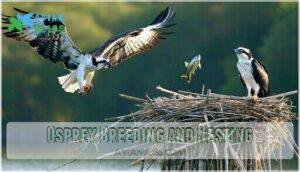This site is supported by our readers. We may earn a commission, at no cost to you, if you purchase through links.

These fish-eating raptors possess unique reversible outer toes that lock fish in place with barbed pads, making them nature’s most successful fishing birds.
They’re found on every continent except Antarctica, diving from heights up to 130 feet at 40 mph speeds to snatch prey.
Unlike other raptors, ospreys can’t fully close their nostrils, preventing water from entering during dives.
Their specialized anatomy includes dense, oily feathers for waterproofing and exceptional eyesight that spots fish from remarkable distances.
These remarkable adaptations reveal just how perfectly evolution has crafted this aerial angler.
Table Of Contents
Key Takeaways
- You’ll identify ospreys by their distinctive white head with a dark eye stripe and an impressive 5-6 foot wingspan – making them larger than red-tailed hawks but smaller than bald eagles
- You’re witnessing nature’s ultimate fishing machine with specialized anatomy – reversible outer toes, barbed foot pads, and waterproof feathers create perfect adaptations for catching slippery fish
- You can spot these remarkable hunters executing dramatic 40 mph dives from heights of up to 130 feet, achieving an impressive 70% hunting success rate through their exceptional underwater vision
- You’ll find ospreys on every continent except Antarctica – they’re among the world’s most widespread raptors, migrating over 5,000 kilometers annually and demonstrating remarkable conservation success after DDT nearly eliminated them
Osprey Physical Traits
You’ll recognize an osprey by its distinctive size and build—these birds measure 21-23 inches long with impressive wingspans stretching 59-71 inches across.
With wingspans stretching nearly six feet, ospreys dominate waterways as nature’s ultimate fishing machines.
Their slender yet robust frame weighs between 3-4 pounds, making them markedly larger than red-tailed hawks but smaller than bald eagles.
Body Shape and Size
You’ll instantly recognize an osprey by its impressive size and shape.
These raptors measure 21-23 inches in body length with a slender build that’s larger than red-tailed hawks but smaller than bald eagles.
Their wing morphology features distinctively long, narrow wings that create an unmistakable M-shaped silhouette during flight.
Body proportions show minimal sexual dimorphism between males and females, which is an interesting aspect of their physical characteristics.
Wingspan and Weight
You’ll discover ospreys possess impressive wingspan and weight measurements that directly impact their hunting success.
These raptors showcase remarkable flight efficiency through their specialized proportions.
Key Osprey Size Measurements:
- Wingspan: 59.1 to 70.9 inches (150-180 cm) for ideal flight efficiency
- Weight: 49.4 to 70.5 ounces (1400-2000g) with weight fluctuation based on season
- Body length: 21.3 to 22.8 inches (54-58 cm) for streamlined hunting
- Size variation: Both sexes show similar measurement techniques and proportions
- Prey size correlation: Weight directly affects the bird’s ability to carry fish
Ospreys boast adaptations for fishing, including reversible toes and barbed talons.
Plumage and Coloration
You’ll recognize osprey birds by their striking brown-and-white plumage pattern.
Adult plumage features dark brown upperparts contrasting with bright white underparts.
Juvenile markings include buff-colored feather edges that fade with age.
This color variation serves important camouflage purposes during hunting.
| Feature | Adult | Juvenile |
|---|---|---|
| Head | White with dark eye stripe | Streaked brown markings |
| Back | Solid dark brown | Brown with buff edges |
| Chest | Pure white | White with brown spots |
| Wings | Dark above, barred below | Mottled brown pattern |
This distinctive color pattern makes raptor identification straightforward, as the feather structure creates perfect contrast for spotting fish underwater.
Distinctive Features
You’ll spot an osprey bird through several unmistakable features that set this raptor apart from other hawks.
Their slender body shape creates a distinctive silhouette in flight, while their specialized anatomy makes raptor identification straightforward.
Key identifying features include:
- M-shaped wings – Creates an unmistakable flight pattern visible from below
- Reversible outer toes – Unique adaptation allowing two-front, two-back grip
- Barbed foot pads – Specialized surfaces that secure slippery fish
- Head-first flight – Carries prey streamlined for reduced wind resistance
These color pattern elements and bird wings characteristics make osprey bird identification reliable even at distance.
Osprey Hunting Behavior
You’ll witness one of nature’s most spectacular hunting displays when an osprey spots a fish below.
Nature’s precision angler strikes with breathtaking speed and surgical accuracy from above.
These specialized raptors hover precisely above water before executing dramatic feet-first dives that can completely submerge them as they snatch prey with razor-sharp talons.
Fishing Techniques
You’ll witness nature’s most precise fishing technique when an osprey hovers 30-130 feet above water, scanning for prey with razor-sharp vision.
This master angler plunges feet-first in spectacular dives, fully submerging to snatch fish with curved talons.
Their hunting efficiency peaks in shallow waters where water clarity allows perfect target acquisition, though dive depth limits them to three feet maximum, showcasing their remarkable razor-sharp vision.
Diet and Prey
Fish dominance defines the osprey’s world.
These specialized raptors consume almost exclusively fish, targeting species like herring, flounder, catfish, mullet, and trout.
Prey size typically ranges from four to twelve inches, weighing 200-400 grams.
You’ll find regional variations in fish species based on local waters.
Their hunting success stems from dietary specialization, with daily needs requiring about three fish to meet energy demands, which is driven by their need to consume almost exclusively fish, and their ability to target a variety of species, including trout.
Hunting Strategies
Ospreys employ strategic hunting methods that maximize their hunting efficiency while minimizing energy expenditure.
You’ll observe them circling slowly above water, scanning for perfect prey selection based on fish size and accessibility. Their dive depth rarely exceeds three feet, limiting them to shallow waters where fish populations concentrate.
Seasonal variation affects their bird hunting strategies, with winter months requiring adaptation to different fish availability.
Their diet consists primarily of fish, and they boast a 70% hunting success rate. This calculated approach guarantees successful bird feeding while conserving essential energy reserves.
Adaptations for Catching Fish
Beyond mere hunting prowess, this fish hawk possesses remarkable physical adaptations that transform it into nature’s ultimate aquatic predator.
Each specialized feature works in perfect harmony to secure slippery prey underwater.
- Reversible toes that grip fish with two talons front and back
- Barbed pads on feet that act like natural fishing gloves
- Underwater vision detecting prey from 130 feet above water
- Fish alignment technique pointing catch head-first for aerodynamic flight
Osprey Habitat and Distribution
You’ll find ospreys on every continent except Antarctica, making them one of the world’s most widespread birds of prey.
They’ve mastered living near water wherever it exists – from coastal shorelines and saltwater estuaries to freshwater lakes, rivers, and wetlands across the globe.
Global Range and Migration
From Alaska to South America, you’ll find these remarkable migratory birds covering over 5,000 kilometers annually.
Migration patterns follow major river systems and coastal corridors as breeding populations travel between continents.
European ospreys winter in West Africa while North American birds reach South America.
This incredible habitat expansion demonstrates their adaptability across diverse ecosystems.
Conservation efforts track these epic journeys, revealing osprey nest sites spanning nearly every continent except Antarctica.
You can purchase products related to osprey migration patterns online.
Nesting Sites and Locations
You’ll find ospreys choosing strategic nesting sites that maximize their hunting success.
These remarkable birds build their osprey nest on artificial platforms, tall trees, or manmade structures positioned 2-40 meters high.
Site reuse is common—some nesting sites serve multiple generations for over a decade, and colony nesting occasionally occurs, though most pairs prefer isolated locations.
Their nesting behavior prioritizes proximity to water sources within 10 kilometers, and nest building involves selecting elevated positions that offer protection from predators while maintaining easy access to fishing grounds.
Many people purchase osprey nesting platforms to encourage local populations.
Coastal and Freshwater Habitats
You’ll find ospreys thriving in diverse aquatic environments where clean water meets abundant fish populations.
These coastal birds prefer wetlands and shallow freshwater ecosystems that support their specialized hunting needs.
- Marshes and estuaries provide ideal coastal ecosystems with easy prey access
- Reservoirs and lakes offer freshwater ecosystems within 10 kilometers of nesting sites
- Clean waterways guarantee healthy fish stocks despite growing habitat threats.
Understanding osprey habitat distribution is vital for conservation.
Waterway proximity remains essential for nesting elevation success, while conservation efforts address regional variations in habitat quality.
Geographic Variations
Ospreys show fascinating regional differences across their global range.
North America hosts larger subspecies with broader wings, while European birds prefer coastal habitat over inland nesting.
Migration patterns vary dramatically—some Australian populations don’t migrate at all.
| Region | Size Differences | Nesting Preferences | Migration Patterns |
|---|---|---|---|
| North America | Largest wingspan, heaviest weight | Inland lakes, artificial platforms | 5,000+ km to South America |
| Europe/Asia | Medium size, streamlined build | Coastal cliffs, tall trees | West Africa wintering grounds |
| Australia | Smallest subspecies, compact frame | Coastal bays, mangrove areas | Non-migratory, year-round residents |
| Africa | Variable size, regional adaptations | Major river systems only | Local movements following water levels |
Osprey Breeding and Nesting
You’ll witness one of nature’s most impressive courtship displays when ospreys perform their aerial dances, complete with dramatic fish deliveries and stick presentations.
These remarkable birds construct massive stick fortresses that can grow to 13 feet deep over generations, creating some of the most substantial nests in the bird world, with dramatic presentations being a key part of their behavior.
Courtship and Mating
When you observe ospreys during breeding season, their courtship rituals become spectacular aerial performances.
Males arrive at nesting sites first, establishing territory before females return. The courtship process involves sky-dancing displays and frequent fish deliveries to potential mates.
Ospreys frequently build their nests in tall, open spaces to defend against predators.
Key courtship behaviors include:
- Aerial displays – Males perform dramatic diving demonstrations near nest sites
- Courtship feeding – Fish deliveries signal male quality and breeding readiness
- Lifetime pairing – Successful pairs often mate for life, showing strong site fidelity
Breeding success depends heavily on male provisioning rates and nesting competition for prime locations.
Nest Construction and Materials
You’ll witness impressive osprey nest construction when males gather sticks while females arrange materials.
These architectural marvels start around 5 feet across but grow with yearly renovations, sometimes reaching massive 13-foot depths.
| Nest Component | Materials Used | Purpose |
|---|---|---|
| Foundation | Large sticks and branches | Structural integrity |
| Body | Medium branches and twigs | Nest size expansion |
| Lining | Grass, algae, soft materials | Comfort and insulation |
Egg-Laying and Incubation
Once you’ve completed the impressive nest, egg-laying begins. Females produce 2-4 eggs at three-day intervals, each resembling large chicken eggs with distinctive brown blotches.
The clutch size depends on food availability and female condition. Incubation lasts 36-43 days, primarily handled by females while males maintain steady fish deliveries.
Parental care includes feeding and protection. Eggs hatch in sequence, creating a size hierarchy among emerging chicks that influences survival rates.
Chick Development and Fledging
Hatchlings emerge as helpless, down-covered chicks that grow remarkably fast, reaching 70% of adult weight within thirty days.
The hatching sequence creates natural chick dominance, with older siblings often outcompeting younger ones for food.
Fledging occurs around seven to eight weeks, though some weaker fledglings may find foster parents. These young birds achieve sexual maturity at approximately three years old.
Osprey Unique Characteristics
What makes ospreys truly extraordinary isn’t just their impressive size or striking appearance.
You’ll discover that these remarkable raptors possess some of the most specialized adaptations in the bird world, from their unique reversible toes to their incredible underwater vision capabilities.
Reversible Toes and Talons
You’ll find that ospreys possess a remarkable evolutionary advantage in their foot morphology – a reversible outer toe that creates a zygodactyl grip.
This bird of prey can position two talons forward and two backward, unlike other raptors with standard bird anatomy.
The unique bird foot anatomy delivers exceptional grip strength for prey capture, allowing these fishing specialists to secure slippery fish weighing up to half their body weight.
This raptor’s specialized bird legs guarantee consistent fishing success through superior control, making them highly efficient fishing specialists.
Specialized Feet and Pads
Those reversible toes work with specialized foot features that give ospreys their legendary grip strength.
Their toes feature rough, spiny pads called spicules that create maximum friction against slippery fish. These backward-facing scales act like tiny barbs, preventing prey from escaping once caught.
Here’s what makes osprey feet so effective:
- Hydrophobic scales keep feet dry during repeated underwater grasping attempts
- High talon sharpness penetrates fish scales with surgical precision
- Exceptional foot flexibility allows adjustment to prey of varying sizes
- Enhanced bird anatomy provides evolutionary advantage over other raptor species.
This specialized bird of prey demonstrates how evolution perfects hunting tools through millions of years of refinement.
Exceptional Vision and Agility
When hunting, you’ll witness a bird predator with vision that’s three to five times sharper than humans.
Ospreys spot fish underwater from 130 feet up, their eyes packed with cone cells for detecting movement and reflections.
Their aerial acrobatics include rapid wingbeat adjustments mid-flight, showcasing flight mastery that enables precise prey detection and hunting precision through underwater vision.
They also possess specialized adaptations like closable nostrils, which are part of their unique characteristics that aid in their hunting prowess, demonstrating their aerial acrobatics.
Conservation Status and Threats
You’ll find osprey conservation represents both triumph and ongoing challenges in wildlife conservation.
DDT nearly wiped out populations by the 1970s through chemical contamination causing eggshell thinning. Today’s recovery efforts have restored stable numbers, though habitat loss and human disturbance create new threats.
- Population decline: DDT pesticides caused 90% population crashes in North America by 1970
- Habitat loss: Coastal development destroys critical nesting and feeding areas
- Chemical contamination: Lead poisoning from fishing gear remains a persistent threat
- Climate change: Shifting fish populations affect osprey food sources and breeding success
- Conservation efforts: Artificial nest platforms and DDT bans enabled remarkable species recovery
Frequently Asked Questions (FAQs)
How big is an osprey?
You’ll spot an osprey as a large hawk measuring 21-26 inches long with a wingspan reaching 59-71 inches.
They’re goose-sized, weighing 3-4 pounds, making them smaller than Bald Eagles but larger than Red-tailed Hawks.
What does a Osprey call mean?
When you’re fishing for answers about bird sounds, an osprey’s call typically serves as communication between mates.
Warning signals to defend territory, or begging calls from hungry chicks seeking food from their parents, are also common functions of an osprey’s call.
Where do Ospreys live?
You’ll find these magnificent raptors on every continent except Antarctica. They thrive near coastlines, lakes, rivers, and wetlands worldwide, from Alaska to South America, building their massive stick nests.
Is Osprey a Canadian bird?
You’ll discover this feathered fisherman isn’t exclusively Canadian – it’s actually a cosmopolitan wanderer.
Ospreys breed across North America, including Canada, but they’re found on every continent except Antarctica, making them global citizens rather than solely Canadian residents.
Is Osprey a hawk or eagle?
You’ll identify an osprey as a hawk, not an eagle.
These fish-eating raptors belong to the hawk family, though they’re specialized hunters with unique adaptations like reversible outer toes for gripping slippery prey.
What does the Osprey symbolize?
You’ve heard that these majestic birds represent spiritual transformation, but let’s dive deeper.
Culturally, you’ll discover they symbolize vision, balance, and mastery over challenges through goal-orientation and keen sight, bridging consciousness with the unconscious domain.
Is an osprey a hawk or an eagle?
Technically, you’re looking at a hawk.
Ospreys belong to the hawk family, though they’re unique enough to have their own subfamily.
They’re larger than typical hawks but smaller than eagles, earning nicknames like "fish hawk" for their specialized hunting skills.
What is so special about osprey?
With 127-180 cm wingspans, you’ll witness nature’s ultimate fishing machine.
Ospreys possess reversible outer toes and barbed foot pads, letting them grasp slippery fish with two toes front and back—a specialized grip no other raptor has mastered, utilizing a specialized grip.
Are ospreys bigger than eagles?
Eagles are generally larger than ospreys.
You’ll find eagles like Bald Eagles outweigh ospreys substantially – eagles reach up to 14 pounds while ospreys max out around 4 pounds, making eagles the bigger birds.
Is it rare to see an osprey?
Spotting soaring seabirds isn’t so scarce nowadays!
You’ll frequently find ospreys near waterways during spring through fall.
Their populations have rebounded substantially since the 1970s, making sightings quite common in suitable habitats.
Conclusion
Discovering these osprey adaptations reveals nature’s incredible engineering.
You’ve learned how reversible toes, specialized vision, and waterproof feathers create the perfect fishing machine.
These remarkable birds demonstrate evolution’s precision in crafting species for specific ecological roles.
Next time you spot an osprey diving into water, you’ll appreciate the millions of years of adaptation that made that spectacular fishing display possible.
The osprey truly stands as one of nature’s most perfectly designed predators, showcasing millions of years of adaptation.














